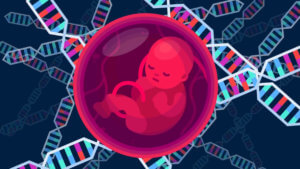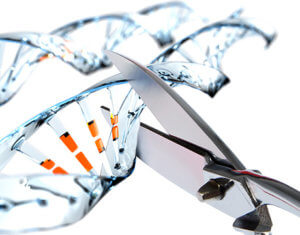It was the inaugural meeting of the International Commission on the Clinical Use of Human Germline Genome Editing. The tone during the day [August 13] was considerably more measured than the media splash that Victoria Gray, a 34-year-old from Mississippi with severe sickle cell disease, had made a few weeks earlier.

She’s the first person to undergo a treatment using CRISPR, but the clinical trial she’s in, sponsored by Vertex Pharmaceuticals, targets only cells that give rise to red blood cells, which shed their DNA as they mature. Victoria is the first of 45 patients expected to enroll, with results in summer 2022.
Altering the germline is a different story.
Keep out, for now
Victoria’s CRISPR treatment is a more precise version of the gene therapy that’s been in clinical trials since 1990, first approved at the end of 2017.
Classical gene therapy as well as the CRISPR version target somatic cells — the germline is off-limits. In fact, when a gene therapy for hemophilia in 2001 veered off-target and wound up in volunteers’ semen, the clinical trial was immediately stalled to correct the glitch, lest the altered DNA pass to the next generation in sperm.
Intentional attempts to alter the human germline simply weren’t done, or known about, until November 2018, when He Jiankui, then of the Southern University of Science and Technology in Shenzhen, China, announced at a conference in Hong Kong and on YouTube that he’d altered the fertilized ova that would become twin girls using CRISPR. They have a bit of DNA missing in the CCR5 gene that shields them from HIV infection, which their father has.
Although condemnation of the audacious experiment was swift, Dr. He pointed to the wishy-washy wording of a 2017 report from the National Academies of Science, Engineering and Medicine, “Human Genome Editing: Science, Ethics, and Governance,” as giving him a go-ahead.

The 2017 tome repeatedly used the phrase “stringent oversight,” yet was vague. A paragraph from the accompanying news release hints at how Dr. He might have concluded that he could proceed:
Heritable germline editing is not ready to be tried in humans. Much more research is needed before it could meet the appropriate risk and benefit standards for clinical trials. The technology is advancing very rapidly, though, making heritable genome editing of early embryos, eggs, sperm, or precursor cells in the foreseeable future ‘a realistic possibility that deserves serious consideration,’ the report says. Although heritable germline genome editing trials must be approached with caution, the committee said, caution does not mean prohibition.
Oops. The last sentence contradicts the preceding three.
More recently, a Russian scientist claims to have couples lining up to undergo CRISPR-mediated genome editing for the same gene that Dr. He targeted.
International commission
Dr. He’s premature experiment provided the backdrop to last week’s meeting. The commission originated at a summit the US, UK and China held in 2015, which called for an ongoing international forum to consider the scientific, clinical and regulatory issues that could arise during a “potential pathway from research to clinical use, if society concludes human genome editing applications are acceptable,” said Victor Dzau, MD president of the U. National Academy of Medicine, as he opened the meeting.
But the gathering didn’t exactly amount to a “do-over” of the paradoxical 2017 report, as one prominent media outlet predicted. Instead, it was more a continuing dialog about what we do and don’t know about editing the germline, and specifically if we know enough to move forward right now. The morning’s speakers provided an overview from basic biology and the afternoon group represented industry, government regulators and patient organizations.
 Reasons to delay
Reasons to delay
Carrie Wolinetz, PhD, chief of staff and associate director for science policy at the National Institutes of Health (NIH), set the cautionary tone:
Editing genes that are passed to the next generation is a huge challenge and requires much higher standards and requirements than for somatic manipulations. NIH believes strongly that now the risks outweigh the benefits, given safety issues and lack of sufficiently compelling medical applications. We need meaningful discussion about the benefits and risks, and for the world’s populations to weigh in.
Dr. Wolinetz, a reproductive physiologist, attended the meeting where Dr. He presented his work, and admits to having been “horrified” for personal reasons: She is a carrier for, and has lost a child to, a rare genetic disease. Yet even she admits to not understanding all of the complexities of germline genome editing.
“I personally would have trouble articulating a truly compelling case for this technology moving forward. If I’m having trouble, that leads me to question how close we are to a real consensus in society about whether or not this technology is acceptable,” Dr. Wolinetz said.
What we need to know
In the next session, Eric Lander, PhD, president and founding director of the Broad Institute of MIT and Harvard, picked up where Dr. Wolinetz left off:
If we decide a particular application is scientifically and medically appropriate, and there’s societal consensus, we still need to evaluate safety and accuracy.
The next four speakers dove into the details.
 Avarinda Chakravarti, PhD, director of the center for human genetics and genomics at the New York University School of Medicine, described the many ways that genomes vary, and how that diversity complicates predicting how a CRISPRed change might affect individuals. We vary at 3 million single-base sites in the genome, and in numbers of repeated sequences, “and those differences make a big difference in terms of health and disease. The human genome is not one monolithic entity,” he said, adding that lifestyle factors and environmental effects modify DNA information.
Avarinda Chakravarti, PhD, director of the center for human genetics and genomics at the New York University School of Medicine, described the many ways that genomes vary, and how that diversity complicates predicting how a CRISPRed change might affect individuals. We vary at 3 million single-base sites in the genome, and in numbers of repeated sequences, “and those differences make a big difference in terms of health and disease. The human genome is not one monolithic entity,” he said, adding that lifestyle factors and environmental effects modify DNA information.
Sarah Teichmann, PhD head of cellular genetics at the Wellcome Sanger Institute, Cambridge, works on the Human Cell Atlas, which is a collection of maps that dissect how genes are expressed under particular conditions in different cell types – knowledge that is imperative to predicting how an edited gene will be “read” in cells other than the type targeted. She compared the atlas to a google map of the human genome, festooned with information.
Chad Cowan, PhD, from the Harvard Stem Cell Institute, offered a succinct and elegant definition of CRISPR: “You break a genome and allow the cell to fix it itself.” Then Britt Adamson, PhD, a molecular biologist from Princeton, highlighted the various ways that cells repair broken chromosomes. Tweaking or mimicking the wrong repair pathway, she warned, can damage DNA, triggering insertions and deletions of chromosomal parts and breaks where paired strands are cut.
More philosophically speaking, it takes hubris to even think that we can do quickly what took evolution many millennia. The real possibility of unintended consequences looms. “We’re a bit naïve in our ability to control these pathways. We don’t really understand a lot of the nuance and regulation,” Dr. Adamson said, referring to the DNA damage response that nature has created.
Choosing targets
In the afternoon, Matthew Porteus, MD, PhD and professor of pediatrics at Stanford, outlined criteria that would justify the risks and unknowns of going ahead with germline genome editing now.
 The first criterion: an absence of alternatives. In vitro fertilization and preimplantation genetic diagnosis, for example, to select embryos free of a specific mutation, are already used. “Putting an embryo through additional manipulation is unlikely to make it to a successful pregnancy,” Dr. Porteus said.
The first criterion: an absence of alternatives. In vitro fertilization and preimplantation genetic diagnosis, for example, to select embryos free of a specific mutation, are already used. “Putting an embryo through additional manipulation is unlikely to make it to a successful pregnancy,” Dr. Porteus said.
Another alternative to modifying a germline genome is somatic genome editing. Sickle cell disease is a perfect candidate, Dr. Porteus explained, because every patient has the same mutation. For a disease that arises from any of thousands of mutations in a single gene, like cystic fibrosis, a gene edit would need to be tailored to each genotype.
Even the obliteration of CCR5 that Dr. He performed on the twin girls seems extreme compared to use of already-in-use anti-retroviral drugs, should the children even become infected with HIV.
A second criterion is to edit a genome only for a serious disease, and certainly not to attempt genetic enhancement. Dr. Porteus envisions an action plan. “We could generate a list of acceptable DNA sequences that are permissible to edit. One proposal this commission might support could be a body similar to the recombinant DNA advisory committee for anyone thinking of doing this process.”
“RACs” arose in the late 1970s when scientists were weighing the risks and benefits of combining DNA from different species. Dr. Porteus mentioned forming a “super RAC” for germline editing in recognition of the global population. “I believe since we are a shared humanity that there should be a shared oversight if anyone determines that they can alter a gene pool. No country gets to do that. It must be an international body.”
Hurdles to implementation
Dr. Wolinetz wasn’t the only one to articulate her fear that we simply don’t yet know enough. Several speakers mentioned a looming problem of a shortage of people trained well enough to be able to review and evaluate submissions to the FDA for germline editing protocols – let alone the search for a “societal consensus” among people familiar with buzzwords perhaps, but not how a particular biotechnology actually works.
 Sarah Norcross, director of the Progress Educational Trust, a consumer organization in the UK concerned with assisted reproduction and genetics, described a study of consumers who thought they could readily explain what genome editing is, but could not define the word “genome.” “We have to make sure that people have a basic understanding of what a genome is,” she said.
Sarah Norcross, director of the Progress Educational Trust, a consumer organization in the UK concerned with assisted reproduction and genetics, described a study of consumers who thought they could readily explain what genome editing is, but could not define the word “genome.” “We have to make sure that people have a basic understanding of what a genome is,” she said.
Sandy Macrae, CEO of SangamoTherapeutics, which has been developing the zinc finger method of somatic gene editing since 2009, brought up ethical concerns:
How do you obtain consent from a patient if what they get is with them for the rest of their days and there’s nothing you can do to take it out? Or tell a parent that what they do to a child will be with the child for life? How would we follow up with people over the long term? We are putting something in a patient that’s going to stay with them. We must take the time to do it carefully.
Bruce Levine, PhD, the Barbara and Edward Netter Professor in Cancer Gene Therapy at the University of Pennsylvania, showed a newspaper article quoting a woman who said of her mysterious stem cell treatment, “I don’t know the science behind my miracle cure and I don’t care.”
But understanding the science does matter, and Dr. Levine fears that germline genome editing clinics will one day pop up like the many clinics promising stem cell miracle cures. “We deal with this in the cell therapy community, the so-called stem cell clinics that are deriving cells from fat, umbilical cord, to treat everything from Alzheimer’s to autism,“ he said. Dr. Levine pioneered CAR-T cell therapy to treat cancer.
Despite the caution and concern among the experts at the meeting, they conceded, as the day wrapped up, that human germline genome editing may be inevitable, especially considering the rich history of now-common procedures, like IVF, that were once widely feared and even ridiculed.
“If our friend in China can do it with minimal assistance and under the radar, and the guy in Russia is threatening to do it, they’re not going to care about the FDA or MHRA (Medicines and Healthcare products Regulatory Agency in the UK) or the EMA (European Medicines Agency),” said Dr. Levine. He asked what conversations the commission should be having now, with the public and regulators as well as with researchers, to slow the pace of the pursuit of human germline genome editing, a topic that will continue at the next meeting, to be held November 14-15 in London.
Meanwhile, the speakers ended with their shared concerns about “bad actors” rushing germline genome editing. Said Dr. Macrae, “My CRISPR friends wake up and worry what they’re going to see in the paper.”
Ricki Lewis is the GLP’s senior contributing writer focusing on gene therapy and gene editing. She has a PhD in genetics and is a genetic counselor, science writer and author of The Forever Fix: Gene Therapy and the Boy Who Saved It, the only popular book about gene therapy. BIO. Follow her at her website or Twitter @rickilewis































